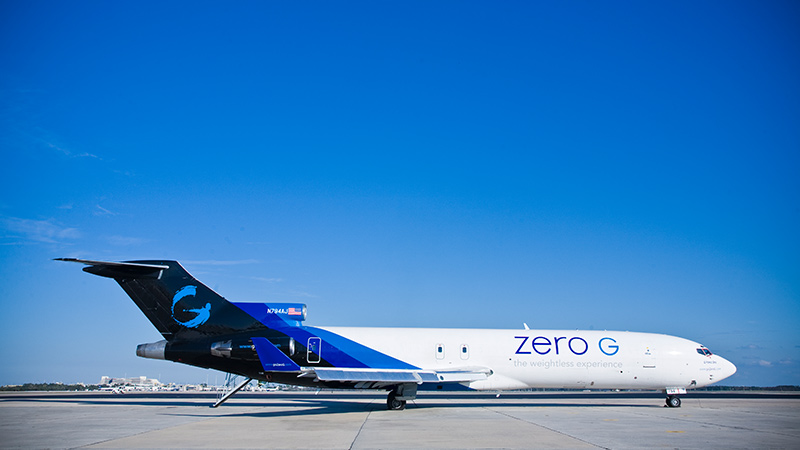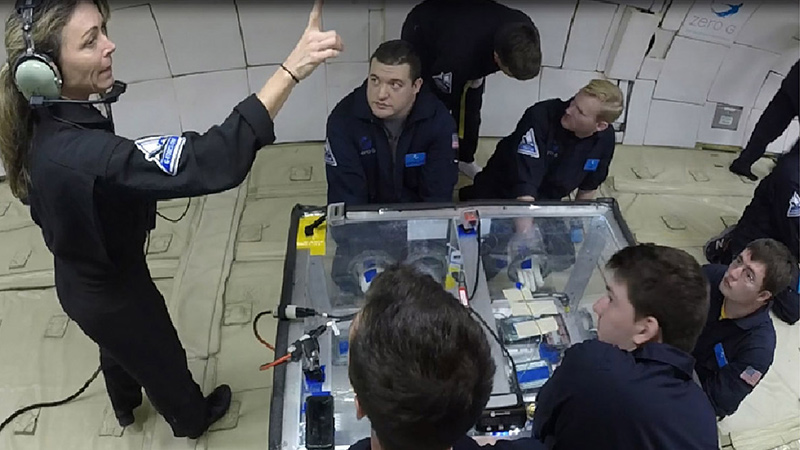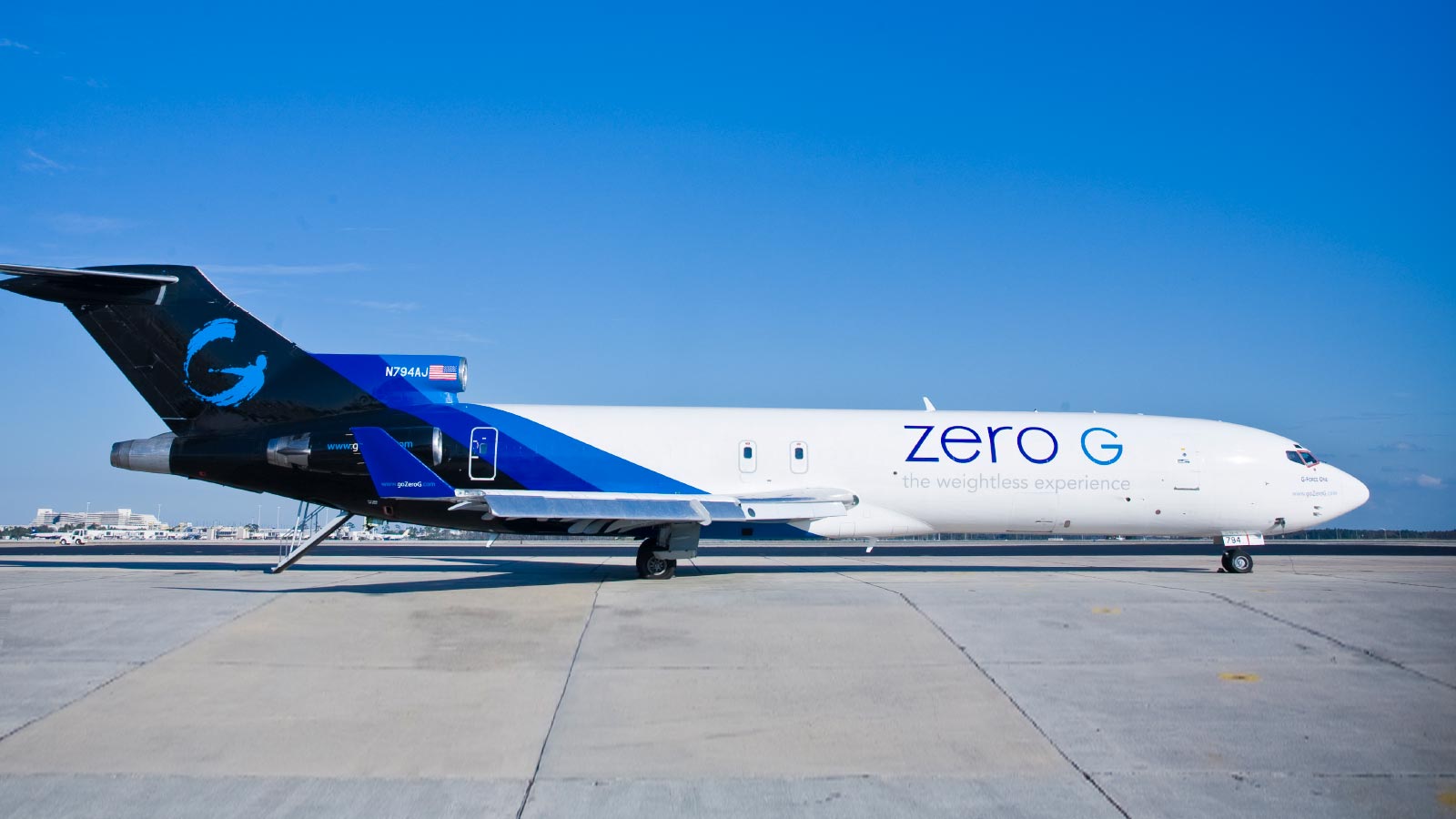Stay Up to Date
Submit your email address to receive the latest industry and Aerospace America news.
Options for conducting experiments are about to grow
This year, just as every year since 2004, a Boeing 727 equipped with an open cabin design and padding over its windows will cruise at 24,000 feet and suddenly ascend at a 45-degree angle to briefly produce 1.8 times the force of gravity. The pilots will throttle back to let momentum carry the plane, and thrilled tourists or often times microgravity scientists will float weightless for about 20 seconds as the plane reaches a peak of 32,000 feet and plunges downward.
Meet G-Force One, an aircraft that in 2004 was a shiny new example of space entrepreneurship. The plane, flown by Virginia-based Zero Gravity Corp., gives tourists willing to pay $4,950, or scientists, a sense that they are in space. The company was the brain child of space entrepreneur Peter Diamandis, former astronaut Byron Lichtenberg, notable as the first space shuttle payload specialist, and former NASA microgravity researcher Ray Cronise. They spent a decade planning the business and winning FAA certification for the flights. The 727, for example, has a modified hydraulic system to prevent dangerous cavitation, or bubbles, from forming.
These days, Zero-G touts itself mainly as a “space entertainment and tourism” company, but it is also a hit with materials scientists, horticulturists and other technologists who crave the experimental mysteries that those few seconds of weightlessness could help them solve.
Today, Zero-G could be called the graybeard of space entrepreneurship. It’s about to have some big-name competition in the microgravity business. Blue Origin plans to offer the New Shepard rocket for suborbital flights by both passengers and experiments in 2018 or as soon as tests can be completed. New Shepard would open up the possibility of researchers accompanying their experiments for three to four minutes. Richard Branson’s Virgin Galactic with SpaceShip Two is moving in the same direction, but without accompanying researchers.
Zero Gravity’s major advantages are capacity and presumably cost. Blue Origin and Virgin Galactic will have longer duration, and slightly “purer” weightlessness. The competition is apparently welcome. “We applaud what they are doing,” says Michelle Peters, Zero Gravity’s director of research and education.
It was NASA that opened the door to this new commercial line of business by stepping out of the way in the same month that Zero-G conducted its first flight. The agency had started a Reduced Gravity Research aircraft program in 1959, and in 2004 it retired the latest iteration of the program’s aircraft, a converted KC-135A fuel tanker dubbed the “Vomit Comet” that hosted experiments and introduced numerous astronauts to the feeling of weightlessness.
For scientists, an attraction of these flights — called parabolas for the shape of the arc the plane makes — is price. G-Force One can take a team of five researchers and all their test equipment from Orlando Sanford International Airport, Florida, over the Gulf of Mexico for $38,500. For some experimenters, the International Space Station would be the preferred venue, but it can cost several times the G-Force One fee just to get an experiment to the station. Plus, the scientists don’t get to accompany their project.
Zero Gravity pilots throttle back engines to just the level necessary to offset drag, so the aircraft proceeds through the parabola at the same speed as before. Weightlessness occurs because both aircraft and its contents are subject to exactly the same forces, momentum plus gravity. More aggressive flying could prolong weightlessness to 28 seconds on G-Force One, notes Peters, but the aircraft generally stays with 20-21 seconds. Flying larger arcs at the parabola’s top can produce lunar or Martian gravity, one-sixth and one-third Earth gravity, respectively.
There are also drop towers. These are inexpensive but the experiment time is brief. The best in the U.S. is at NASA’s Glenn Research Center in Ohio, and it offers only five seconds of zero gravity. The Japanese Microgravity Center used an abandoned vertical mine shaft near Hokkaido, Japan, to achieve approximately 10 seconds of drop with gas thrusters and other equipment, but the facility is no longer operational.
Sounding rockets, which reach suborbital altitudes, are another option but these offer opportunities for only unmanned flights and experiments. The size and weight of the experimental equipment are also restricted.
Experiments aboard G-Force One in recent months provide a window into the variety of applications for parabolic flights that have sprouted since Diamandis and his team founded the company. Here are examples:
Soldering
For space explorers or those seeking to set up commercial bases in space, soldering in microgravity could become necessary. Electronic components might at some point fail, and it would be impossible to have a replacement part available for every scenario. Odds are, circuitry, for instance, is going to have to be repaired. Soldering in microgravity could be risky, says John Kuhlman, professor emeritus of mechanical and aerospace engineering at West Virginia University, who has conducted experiments on G-Force One.
The problem, as NASA learned in a KC-135 parabolic experiment, is that in microgravity vapors can remain in the solder as tiny bubbles that weaken joints. Here on Earth, the weight of the solder pushes it downward and vapor bubbles up and out through the surface of the solder, much as gravity pushes bubbles up in carbonated water or soda.
Experiments at Yale University and analysis by Kuhlman at West Virginia suggested a possible solution: Put tiny iron pieces in solder and draw the iron and solder to the soldered joint with magnets, pushing the bubbles up and out like gravity. “That should improve the longevity of repairs on electronics,” Kuhlman says.
Kuhlman chose Zero-G because his prior experience with parabolic flight taught him that 20-21 seconds of weightlessness would be long enough for solder to melt and solidify. West Virginia’s own drop tower yields only one or two seconds of zero gravity, hardly long enough, and it would need an automated experiment. NASA’s sounding rockets flying suborbital parabolas could yield much longer durations, but would require miniaturized and automated equipment, adding to costs. And use of ISS would dramatically increase cost and delays.
To ensure the experiment did not interfere with the 727’s communication and avionics, the West Virginia team used small, rare-Earth permanent magnets placed close to the solder.
Their magnetic fields decline rapidly as distance lengthens. Zero-G and experimenters always verify beforehand that equipments and processes will not interfere with safe flights.
The research team went through an orientation program to understand what would happen during flight and how to handle safety equipment like vests. In addition, Zero Gravity assigned a coach to help experimenters with the exercise. The coach was also trained to take over from a team member if one were disabled, for example by sickness.
As it happened, one student was disabled and the coach took his place. On Nov. 15, 2017, Kuhlman’s team flew 30 parabolas, soldering individual joints and also using reflow ovens to solder components to circuit boards. Another planned experiment, using induction heating, was not done due to safety concerns that the required cooling water might leak.
By January 2018, West Virginia researchers had visually inspected the magnetized solders and prepared them for the instrumental analysis necessary to detect the amount of air space per solder volume. Analysis of results will take months.
Kuhlman plans on more experiments, one with an improved solder that should have stronger magnetic attraction and still another that may not require magnets to prevent bubbles.
Vegetation experiment
Space explorers will surely want to grow their own vegetables, because produce can’t be preserved long and transporting it to space would take up scarce and valuable delivery capacity.
But microgravity poses problems, says Audrey Webb, division chair and instructor at Gadsden State Community College in Alabama. There’s no force to pull water down to plant roots so it can feed the plants’ growth. Different techniques might have to be used to get water to the roots and then tools developed to determine when the system needed more water.
Webb chose Zero-G partly because the space station was too expensive, $80,000 to $90,000 for just the one-way transport of an earlier experiment. Also, her students could perform the tests, rather than turning them over to astronauts. Finally, results would come quicker than the three months to get data back from ISS.
Webb’s team went up on a 30-parabola flight. The Zero-G pilots can tailor the amount of gravity during parabola, and the first five parabolas simulated lunar and Martian gravity. Then pairs of researchers each tried five parabolas at a time to observe, with sensors and cameras, where water went. Various techniques were used for watering plants.
Webb’s team first tested water flows into Turface, a cat-litter-like material used on athletic fields. Moisture sensors were embedded in Turface and triggered a water pump to maintain constant moisture. The researchers showed that moisture could be distributed by capillary action within the Turface.
Another experiment of Webb’s tested aeroponics, which grows plants in mist without soil, to water roots, represented by sponge, Mylar and Teflon. Water colored with green food dye was atomized and sprayed toward plant roots in zero gravity in a closed container for five seconds during each parabola. Unfortunately, the mist blocked cameras recording the experiment, but the green dye showed up on roots, indicating success. Webb says sensor results were generally satisfactory. But cameras had a tendency to fog up and need to be redesigned.
By January 2018, Webb was working on next steps, tweaking the watering and measuring processes to improve results. She says the 20-second zero gravity is sufficient for preliminary experiments, but if she finds an encouraging approach to the problem she might opt to put an experiment on a three-month test on the space station.
Asteroid mining
Government and private organizations are getting closer to exploring and perhaps mining asteroids. For mining, asteroids could someday produce rare elements less expensively than digging into mountains on Earth or yield water embedded in asteroid material. If water can be broken down into its constituent oxygen and hydrogen, asteroids could serve as refueling stations for rockets.
Safety is among many questions posed by asteroid mining, according to Josh Colwell, a physicist at the University of Central Florida. The very slight gravity of asteroids means surface material, called regolith, could be kicked up by just slight impacts from mining activity.
So Colwell has been experimenting with simulated regolith, developed from examining meteorites, which are fragments of asteroids. Tests in November 2017 on Zero Gravity’s 727 shot 2-centimeter marbles into the simulated regolith. They revealed that only at impact speeds of less than 20 centimeters per second, extremely slow, is the regolith relatively undisturbed and safe.
Colwell also studied faster impacts and their effects, for operators that might want to collect samples of the asteroid’s regolith. And in the course of his experiments, Colwell’s team collected data on how an impact might cause a chunk to bounce off the surface, which has implications for scientific questions about the early stages of planet formation.
The Florida researcher has used other microgravity environments, including a drop tower, suborbital parabolas and the space shuttle, to conduct asteroid experiments. He says it is a big advantage to actually be on the Zero Gravity aircraft, and he can do many 10-second experiments on one flight.
Credit for photo at top of story: European Space Agency
About Amanda Miller
Amanda is a freelance reporter and editor based near Denver with 20 years of experience at weekly and daily publications.
Related Posts
Stay Up to Date
Submit your email address to receive the latest industry and Aerospace America news.







